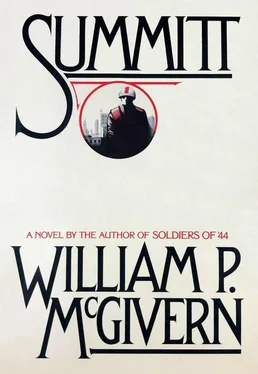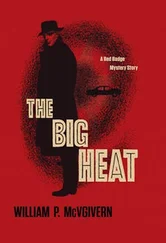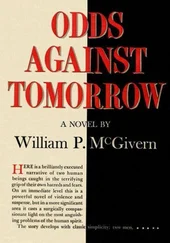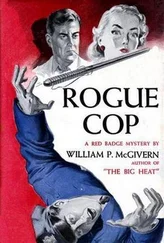“Of course I do, Davey.”
But the truth was that Selby wasn’t sure of anything now. He knew Shana was deeply afraid, deeply upset. He knew that, and not much else. And he didn’t know where to look for help, for the truth. And worse, he didn’t know where to turn his eyes to avoid it.
The next morning Selby put his father’s diaries in the car and drove to Muhlenburg and picked up the information Miss Culpepper had collected for him. A spinster with white hair and a straight back, Miss Culpepper and Sarah had been close friends. Selby had asked her to check the library for material relating to Harlequin Chemicals. Taking the request as a starting point, Miss Culpepper had put together a package of magazine articles (from Fortune and Time and Commentary and others) which embraced not only Harlequin and the Correll Group but touched on various publicly reported aspects of their relationship with the U.S. military and Congress.
Selby stacked the material on the rear seat of his station wagon and drove north out of Muhlenburg into the network of secondary roads leading toward Buck Run.
At the Stoneville school, three miles from the switching yards, he drove around the hockey and soccer fields. He traveled in widening circles then until he came at last to a road that cut through pasturelands and dead-ended on the White Clay Creek.
Twice that morning he spotted a dusty gray Ford on the road behind him. At a market outside Buck Run he bought a baked ham sandwich, a bunch of grapes and two cans of beer. The girl at the counter gave him some homemade horseradish in a twist of waxed paper. She recommended the barrel pickles her father put up. Selby said next time.
There were no cars at the gas pumps. A young man in jeans and a red wool shirt sat reading a paperback beside a rack of new tires.
“Not much business today,” Selby commented.
“Well, it’s early, truckers’ll be stopping by pretty soon for gas and lunch.”
“You do lube jobs?”
“Not much call for that, sir.”
“Take care,” Selby said and got into the station wagon and drove off. The gray Ford had been parked in the service garage beside the market, but Selby hadn’t been able to get a good look at the driver. It was a man with a newspaper in front of his face.
Selby stopped on the Buck Run road in the shade of a big maple tree and ate the ham sandwich with horseradish and drank one of the beers. The breezes stirred the leaves and blew them against his windshield where they stuck in yellow and brown patterns. A herd of Holsteins, black and white like huge dominoes, huddled together in the lee of a barn.
Selby watched the road behind him in the rear-view mirror. It was flat and empty and curved out of sight through a grove of black locusts.
Selby opened his father’s diaries and glanced through them. It was frustrating to study the cramped handwriting and not be able to wring some truth or significance from it.
The diaries were in three parts: the time in Korea, the time in the army stockade and hospital, and the time in California with his wife and Jarrell.
Three names were prominent in the Korean period: the chief, the major and a lieutenant named Kraager, all with the 916th Counter-Intelligence Section, a unit attached to the 7th Division. In the Chinese spring offensive, Jonas Selby mentioned the Kwach-on Reservoir, the retreat to Munsan-ni — the battle of the hills, the 1st Marines on Bunker Hill and the 3rd Division with Belgian and Greek Allied units on Big Nori and Kelly Hill... the 7th on the Triangle and a ROK Division on Whitehorse Hill.
It seemed unreal to drink beer on a dusty country road in Pennsylvania and read about those distant battles and to realize that the people living there now, farmers working the soil, children bicycling to school, had probably never heard of those place names coined by PR officers and war correspondents for American radio networks and newspapers. Arrowhead Hill and Heartbreak Ridge and Old Baldy — what did Koreans call them today?
In that phase there was evidence of a young man who had looked at the world in a wistful, innocent way. His father had listed the names of railroads and trains he must have ridden or seen or heard about — the Monon and the Nickel Plate, the Wabash and Southern Pacific, the Santa Fe, the Pennsy’s Broadway and the New York Central’s Twentieth Century. The “Q” (the Chicago, Burlington and Quincy) and the Boston and Maine’s Owl, the Baltimore and Ohio and the Erie and the Soo...
Jonas Selby had written down the words to The Legend of John Henry — “I’ll die with my hammer in my hand...” And John Henry’s shout of defiance to the steam drill — “How are you, Mr. Steam Drill? I’m talking to you .”
There were notes about cattle drives and railroad corrals — laments of young men — “The hills are all climbed, the creeks are all past...”
It seemed of a piece. Except why had his father copied out the words of The Bonnie Earl of Murray? “Ye Highlands and ye Lawlands / Oh where hae ye been? / They hae slain the Earl of Murray / And hae laid him on the green.”
But one thing was clear... Jonas Selby had been involved in something that frightened him. It was scattered throughout the entries over a period of several months. “I’ll pay for it — we all will.”
Then came Jonas Selby’s court-martial. And a one-word entry that read: “Nailed!”
The diary stopped there for almost five years. It resumed in the army hospital in Colorado, where he met his wife, Rita — Jarrell’s mother...
The Holsteins were drifting out from the shelter of the sprawling barn; the wind had eased off. Some were lumbering across the field toward Selby’s station wagon. Others were drifting down to the locust trees where the road curved out of sight.
That’s where the gray Ford must be parked, he guessed, just out of sight around the bend.
Having played violent games much of his adult life, Selby’s protective instincts had become honed to a fine, reflexive edge; his peripheral vision was automatic, and his awareness of his terrain was near-reflexive.
On offense or defense the rules were the same: if you didn’t have a healthy built-in paranoia you stood an excellent chance of winding up in a basket typing your memoirs with your nose, since it was computed that the energy created by a pair of two-hundred-pound men running into each other at full speed (coaches liked to mention this) could overcome the inertia of a twenty-ton block of steel and jolt it one full inch from the point of impact.
If you were blind-sided by that crunch, the physical penalties would be extreme, and they didn’t usually get you any sympathy. No one was sorry for fools, and if you weren’t paranoid about protecting yourself, that’s what you were, a damned fool...
He checked the rear-view mirror, started the car and drove away from the staring cows. At the first curve he floored the accelerator. The station wagon picked up speed rapidly and the tires raised a screen of dust behind it. At the first curve he cut the motor and coasted off the road into a hedge of beech trees. He could hear the sound of an approaching car in the country silence. When the gray Ford shot past, there was too much dust for him to see the driver, but he got what he wanted — the car’s license number. Thanks to that old acute football-field vision.
In Buck Run he stopped at a drugstore and called the insurance man Jay Mooney’s office. Mooney’s secretary told him Jay was at lunch but asked if she could help. Selby explained that someone had nicked his fender in a supermarket lot in East Chester but left only a license number on a piece of paper under his windshield wiper. No name or address. He asked her if she would find out who the driver was.
Читать дальше

![Уильям Макгиверн - Завтра опять неизвестность [английский и русский параллельные тексты]](/books/35168/uilyam-makgivern-zavtra-opyat-neizvestnost-angli-thumb.webp)









